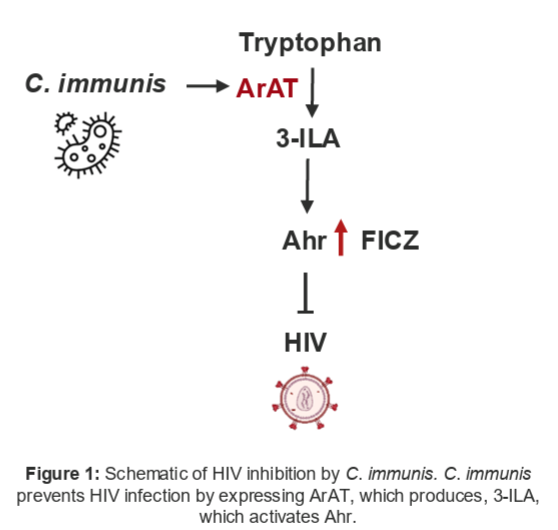Principal Investigator:
Ria Goswami, Assistant Professor of Virology in Pediatrics
Background & Unmet Need
- There are few antivirals for many viral infections including SARS-CoV-2, influenza, Zika, and CMV
- Limited access to antiretroviral therapy (ART) underlies most new HIV infections and HIV-related deaths
- Barriers to ART and other antivirals include toxicity, side effects, financial constraints, and lack of access to medical care
- There are few broad-spectrum antivirals, which would have the capacity to treat several different viruses
- Unmet Need: Development of novel antiviral strategies to overcome the lack of effective treatments, toxicity of current ARTs, and barriers to medicine for viral infections
Technology Overview
- The Technology: Methods of preventing viral infection, including HIV or CMV, using an aryl hydrocarbon receptor (AhR) agonist or Lachnospriaceae family bacteria
- The Discovery: Lachnospriaceae family members Clostridium immunis (C. immunis) and Ruminococcus gnavus (R. gnavus) metabolize tryptophan into 3-indolelactic acid (3-ILA) via Aromatic Amino Acid Aminotransferase (ArAT)
- 3-ILA and FICZ (an alternative agonist) can prevent HIV infection by binding to aryl hydrocarbon receptor (AhR)
- PoC Data: Administration of C. immunis as a live biotherapeutic suppresses active HIV replication by up to 80-90% in vitro in an ArAT dependent manner
- Administration of FICZ suppresses active HIV replication by up to 50% in vitro
Technology Applications
- Use of small molecule AhR agonists or Lachnospriaceae live biotherapeutics to prevent HIV infection in infants who breast-feed from HIV-positive mothers
- Prevention or treatment of other viral infections including HIV, CMV, and potentially SARS-CoV-2, influenza, Hepatitis C, and Zika
Technology Advantages
- AhR agonists or Lachnospriaceae bacteria are broad-spectrum and can be used for co-infections
- Prolonged colonization of Lachnospriaceae in patients can prevent the need for re-dosing
- AhR agonists or Lachnospriaceae can be used as a monotherapy, rather than in combination like ARTs
- May overcome the toxicity of current ART regimens

Publications
Resources
Intellectual Property
Patents
- PCT Application Filed WO2024173808A1: "Microbiome-derived compositions and methods for the prevention and treatment of viral infections"
Cornell Reference
- 10621
Contact Information

For additional information please contact
Jamie Brisbois
Manager, Business Development and Licensing
Phone: (646) 921-4743
Email: jamie.brisbois@cornell.edu

